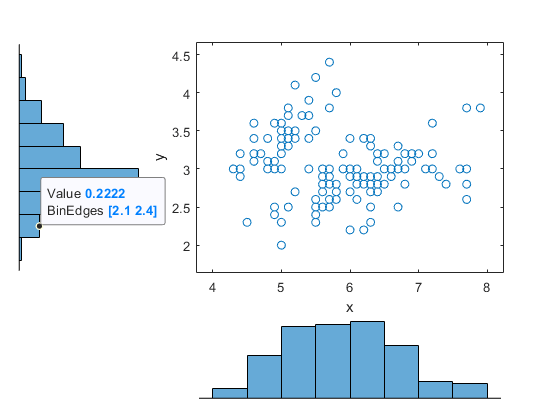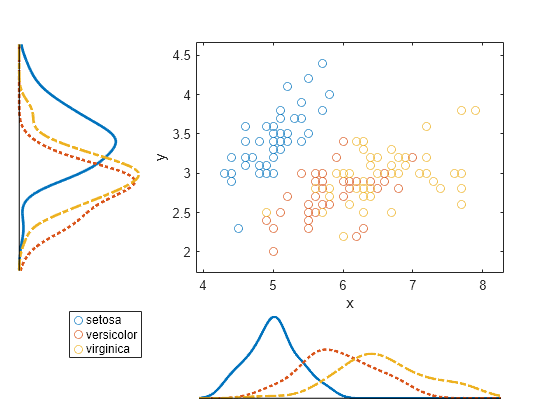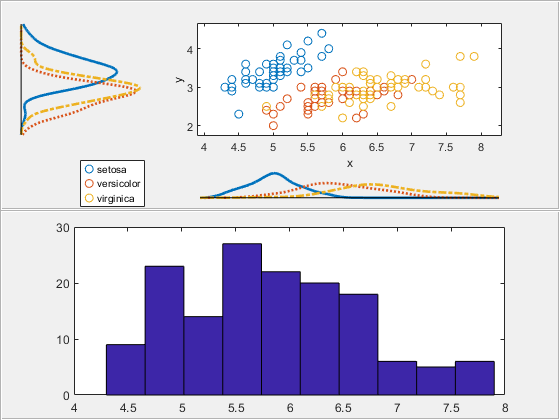scatterhist
Scatter plot with marginal histograms
Description
scatterhist( creates
the plot using additional options specified by one or more name-value
pair arguments. For example, you can specify a grouping variable or
change the display options.x,y,Name,Value)
Examples
Load the sample data. Create data vector x from the first column of the data matrix, which contains sepal length measurements from iris flowers. Create data vector y from the second column of the data matrix, which contains sepal width measurements from the same flowers.
load fisheriris
x = meas(:,1);
y = meas(:,2);Create a scatter plot and two marginal histograms to visualize the relationship between sepal length and sepal width.
scatterhist(x,y)

Display a data tip for a bin in a histogram. A data tip appears when you hover over a bin in a histogram.

The data tip displays the probability density function estimate of the selected bin and the lower and upper values for the bin edges.
Load the sample data. Create data vector x from the first column of the data matrix, which contains sepal length measurements from three species of iris flowers. Create data vector y from the second column of the data matrix, which contains sepal width measurements from the same flowers.
load fisheriris.mat;
x = meas(:,1);
y = meas(:,2);Create a scatter plot and six kernel density plots to visualize the relationship between sepal length and sepal width, grouped by species.
scatterhist(x,y,'Group',species,'Kernel','on')

The plot shows that the relationship between sepal length and width varies depending on the flower species.
Load the sample data. Create data vector x from the first column of the data matrix, which contains sepal length measurements from three different species of iris flowers. Create data vector y from the second column of the data matrix, which contains sepal width measurements from the same flowers.
load fisheriris.mat;
x = meas(:,1);
y = meas(:,2);Create a scatter plot and six kernel density plots to visualize the relationship between sepal length and sepal width as measured on three species of iris flowers, grouped by species. Customize the appearance of the plots.
scatterhist(x,y,'Group',species,'Kernel','on','Location','SouthEast',... 'Direction','out','Color','kbr','LineStyle',{'-','-.',':'},... 'LineWidth',[2,2,2],'Marker','+od','MarkerSize',[4,5,6]);

Load the sample data. Create data vector x from the first column of the data matrix, which contains sepal length measurements from three species of iris flowers. Create data vector y from the second column of the data matrix, which contains sepal width measurements from the same flowers.
load fisheriris.mat;
x = meas(:,1);
y = meas(:,2);
Use axis handles to replace the marginal histograms with box plots.
h = scatterhist(x,y,'Group',species); hold on; clr = get(h(1),'colororder'); boxplot(h(2),x,species,'orientation','horizontal',... 'label',{'','',''},'color',clr); boxplot(h(3),y,species,'orientation','horizontal',... 'label', {'','',''},'color',clr); set(h(2:3),'XTickLabel',''); view(h(3),[270,90]); % Rotate the Y plot axis(h(1),'auto'); % Sync axes hold off;

Load the sample data. Create data vector x from the first column of the data matrix, which contains sepal length measurements from iris flowers. Create data vector y from the second column of the data matrix, which contains sepal width measurements from the same flowers.
load fisheriris
x = meas(:,1);
y = meas(:,2);Create a new figure and define two uipanel objects to divide the figure into two parts. In the upper half of the figure, plot the sample data using scatterhist. Include marginal kernel density plots grouped by species. In the lower half of the figure, plot a histogram of the sepal length measurements contained in x.
figure hp1 = uipanel('position',[0 .5 1 .5]); hp2 = uipanel('position',[0 0 1 .5]); scatterhist(x,y,'Group',species,'Kernel','on','Parent',hp1); axes('Parent',hp2); hist(x);

Input Arguments
Sample data, specified as a vector. The data vectors x and y must
be the same length.
If x or y contain NaN values,
then scatterhist:
Removes rows with
NaNvalues in eitherxoryfrom both data vectors when generating the scatter plotRemoves rows with
NaNvalues only from the correspondingxorydata vector when generating the marginal histograms
Data Types: single | double
Sample data, specified as a vector. The data vectors x and y must
be the same length.
If x or y contain NaN values,
then scatterhist:
Removes rows with
NaNvalues in eitherxoryfrom both data vectors when generating the scatter plotRemoves rows with
NaNvalues only from the correspondingxorydata vector when generating the marginal histograms
Data Types: single | double
Name-Value Arguments
Specify optional pairs of arguments as
Name1=Value1,...,NameN=ValueN, where Name is
the argument name and Value is the corresponding value.
Name-value arguments must appear after other arguments, but the order of the
pairs does not matter.
Before R2021a, use commas to separate each name and value, and enclose
Name in quotes.
Example: 'Location','SouthEast','Direction','out' specifies
a plot with histograms located below and to the right of the scatter
plot, with the bars directed away from the scatter plot.
Number of bins for histograms, specified as the comma-separated
pair consisting of 'NBins' and a positive integer
value greater than or equal to 2, or vector of two such values. If
the number of bins is specified as a positive integer value, that
value is the number of bins for both the x and y histograms.
If the number of bins is specified by a vector, the first value is
the number of bins for the x data, and the second
value is the number of bins for the y data. By
default, the number of bins is computed based on the sample standard
deviation using Scott’s rule.
Example: 'NBins',[5,7]
Data Types: single | double
Location of the marginal histograms in the figure, specified
as the comma-separated pair consisting of 'Location' and
one of the following.
'SouthWest' | Plot the histograms below and to the left of the scatter plot. |
'SouthEast' | Plot the histograms below and to the right of the scatter plot. |
'NorthEast' | Plot the histograms above and to the right of the scatter plot. |
'NorthWest' | Plot the histograms above and to the left of the scatter plot. |
Example: 'Location','SouthEast'
Direction of the marginal histograms, specified as the comma-separated
pair consisting of 'Direction' and one of the following.
'in' | Plot the histograms with the bars directed toward the scatter plot. |
'out' | Plot the histograms with the bars directed away from the scatter plot. |
Example: 'Direction','out'
Grouping variable, specified as the comma-separated pair consisting of
'Group' and a categorical array, logical or
numeric vector, character array, string array, or cell array of
character vectors. Each unique value in a grouping variable defines a
group.
For example, if Gender is a cell array of character
vectors with values 'Male' and
'Female', you can use Gender
as a grouping variable to plot your data by gender.
The number of rows in the grouping variable must be equal to the
length of x.
Example: 'Group',Gender
Data Types: categorical | single | double | logical | char | string | cell
Grouped plot indicator, specified as the comma-separated pair
consisting of 'PlotGroup' and one of the following.
'on' | Display grouped histograms or grouped kernel density plots.
This is the default if a Group parameter is specified. |
'off' | Display histograms or kernel density plots of the whole data
set. This is the default if a Group parameter
is not specified. |
Example: 'PlotGroup','off'
Histogram display style, specified as the comma-separated pair
consisting of 'PlotGroup' and one of the following.
'stairs' | Display a stairstep plot that shows the outline of the histogram without filling the bars. This is the default if you specify a grouping variable that contains more than one group. |
'bar' | Display a histogram bar plot. This is the default if you specify
a grouping variable that contains only one group or if PlotGroup is
specified as 'off'. |
Example: 'Style','bar'
Kernel density plot indicator, specified as the comma-separated
pair consisting of 'Kernel' and one of the following.
'off' | Display the marginal distributions as histograms. |
'on' | Display the marginal distributions as kernel density plots. |
'overlay' | Display the marginal distributions as kernel density plots
overlaid onto histograms, similar to histfit. |
Example: 'Kernel','overlay'
Bandwidth of kernel smoothing window, specified as the comma-separated
pair consisting of 'Bandwidth' and a matrix of
size 2-by-K, where K is the
number of unique groups. The first row of the matrix gives the bandwidth
of each group in x, and the second row gives the
bandwidth of each group in y. By default, scatterhist finds
the optimal bandwidth for estimating normal densities. Specifying
a different bandwidth value changes the smoothing characteristics
of the resulting kernel density plot. The value specified is a scaling
factor for the normal distribution used to generate the kernel density
plot.
Example: 'Bandwidth',[.5,.2,.1;.15,.25,.35]
Data Types: single | double
Legend visibility indicator, specified as the comma-separated
pair consisting of 'Legend' and one of the following.
'on' | Set legend visible. This is the default if a Group parameter
is specified. |
'off' | Set legend invisible. This is the default if a Group parameter
is not specified. |
Example: 'Legend','on'
Style of kernel density plot line, specified as the comma-separated pair consisting of
'LineStyle' and a valid line style or a string
array or cell array of valid line styles. See plot for valid line
styles. The default is a solid line. Use a string array or cell array to
specify different line styles for each group. When the total number of
groups exceeds the number of specified values,
scatterhist cycles through the specified
values.
Example: 'LineStyle',{'-',':','-.'}
Data Types: char | string | cell
Width of kernel density plot line, specified as the comma-separated
pair consisting of 'LineWidth' and a nonnegative
scalar value or vector of nonnegative scalar values. The specified
value is the size of the kernel density plot line measured in points.
The default size is 0.5 points. Use a vector to specify different
line widths for each group. When the total number of groups is greater
than the number of specified values, scatterhist cycles
through the specified values.
Example: 'LineWidth',[0.5,1,2]
Data Types: single | double
Marker color for each scatter plot group, specified as the comma-separated pair consisting of
'Color' and a character vector or string scalar
of color names, or a three-column matrix of RGB values in the range
[0,1]. If you specify colors using a matrix, then each row of the matrix
is an RGB triplet that represents a group. The three columns of the
matrix represent the R value, G value, and B value, respectively. When
the total number of groups exceeds the number of specified colors,
scatterhist cycles through the specified
colors.
This table lists the predefined colors and their equivalent RGB triplet values.
| Option | Description | Equivalent RGB Triplet |
|---|---|---|
'red' or
'r' | Red | [1 0 0] |
'green' or
'g' | Green | [0 1 0] |
'blue' or
'b' | Blue | [0 0 1] |
'yellow' or
'y' | Yellow | [1 1 0] |
'magenta' or
'm' | Magenta | [1 0 1] |
'cyan' or
'c' | Cyan | [0 1 1] |
'white' or
'w' | White | [1 1 1] |
'black' or
'k' | Black | [0 0 0] |
Example: 'Color','kcm'
Example: 'Color',[.5,0,1;0,.5,.5]
Data Types: single | double | char | string
Marker symbol for each scatter plot group, specified as the comma-separated pair consisting of
'Marker' and a character vector or string scalar
of one or more valid marker symbols. See plot for valid symbols.
The default is 'o', a circle. When the total number
of groups exceeds the number of specified symbols,
scatterhist cycles through the specified
symbols.
Example: 'Marker','+do'
Data Types: char | string
Marker size for each scatter plot group, specified as the comma-separated
pair consisting of 'MarkerSize' and a nonnegative
scalar value or a vector of nonnegative scalar values, measured in
points. When the total number of groups exceeds the number of specified
values, scatterhist cycles through the specified
values.
Example: 'MarkerSize',10
Data Types: single | double
Output Arguments
Axes handles for the three plots, returned as a vector. The vector contains the handles for the scatter plot, the histogram along the horizontal axis, and the histogram along the vertical axis, respectively.
Alternative Functionality
Alternatively, you can create a ScatterHistogramChart object by
using the scatterhistogram function.
Explore the data interactively in the object by panning, zooming, and using data tips. Unlike the
scatterhistfunction,scatterhistogramupdates the marginal histograms based on the data within the current scatter plot limits.Control the appearance and behavior of the scatter histogram chart by changing the ScatterHistogramChart Properties.
Version History
Introduced in R2007aWhen the plot contains up to 12 colors, the scatterhist function uses the
gem12 color palette in light mode and the glow12
color palette in dark mode. When the plot contains more than 12 colors, the function uses
the hsv colormap. For more information on color palettes for visualizing
multiple data series, see orderedcolors.
MATLAB Command
You clicked a link that corresponds to this MATLAB command:
Run the command by entering it in the MATLAB Command Window. Web browsers do not support MATLAB commands.
Website auswählen
Wählen Sie eine Website aus, um übersetzte Inhalte (sofern verfügbar) sowie lokale Veranstaltungen und Angebote anzuzeigen. Auf der Grundlage Ihres Standorts empfehlen wir Ihnen die folgende Auswahl: .
Sie können auch eine Website aus der folgenden Liste auswählen:
So erhalten Sie die bestmögliche Leistung auf der Website
Wählen Sie für die bestmögliche Website-Leistung die Website für China (auf Chinesisch oder Englisch). Andere landesspezifische Websites von MathWorks sind für Besuche von Ihrem Standort aus nicht optimiert.
Amerika
- América Latina (Español)
- Canada (English)
- United States (English)
Europa
- Belgium (English)
- Denmark (English)
- Deutschland (Deutsch)
- España (Español)
- Finland (English)
- France (Français)
- Ireland (English)
- Italia (Italiano)
- Luxembourg (English)
- Netherlands (English)
- Norway (English)
- Österreich (Deutsch)
- Portugal (English)
- Sweden (English)
- Switzerland
- United Kingdom (English)